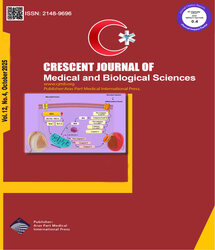

| Original Article | |
| Impact of ABO Blood Group on Prosthetic Valve Thrombosis: A Single Center Study | |
| Ahmad Separham, Hassan Javadzadegan, Samad Ghaffari, Naser Aslanabadi, Bahram Sohrabi, Seyed Sajjad Mahmoudi, Morteza Gojazadeh, Elgar Anamzadeh, Reza Hajizadeh, Mohammadreza Taban Sadeghi | |
| Cardiovascular Research Center, Tabriz University of Medical Sciences, Tabriz, Iran | |
|
CJMB 2017; 4: 013-016 Viewed : 4369 times Downloaded : 3409 times. Keywords : Prosthetic valve thrombosis, ABO group, Non-O blood group |
|
| Full Text(PDF) | Related Articles | |
| Abstract | |
Objective: Prosthetic valve thrombosis (PVT) is an obstruction of a valve prosthesis by non-infective thrombotic material. A number of studies have reported an association between ABO blood groups and thromboembolic events. Little is known about impact of ABO groups on prosthetic valve thrombosis. Therefore, we studied the distribution of ABO blood groups in patients with PVT. Material and Methods: This was a single center retrospective cohort of patients with PVT during ten years period in the northwest of Iran. All patients received intensified anticoagulation or thrombolysis or redo surgery according to physician decision. Then, all patients divided into two blood group: O and non-O group, and in-hospital adverse events and mortality were compared between groups. Results: During 10-year period, there were 85 episodes of PVT in 80 patients. Number of patients who developed PVT according to ABO group were: 23 (27%) in group A, 23 (27%) in group B, 12 (14.1%) in group AB and 27 (31.7%) in group O. Overall, 58 (68.2%) patients had non-O blood group. There was no significant difference in distribution of ABO group between general cohort and patients with PVT (P = 0.81). Failed thrombolysis occurred only in group non-O patients (P = 0.0001). Also 4 (14.8%) patients in group O and 13(22.4%) in group non-O died (P = 0.4). Conclusion: There was no association between ABO blood group and PVT. Complication were more in non-O blood group. Failed thrombolysis was developed only in non-O patients. Larger studies are needed to better define this issue. |
Cite By, Google Scholar
Google Scholar
PubMed
Online Submission System
 CJMB ENDNOTE ® Style
CJMB ENDNOTE ® Style
 Tutorials
Tutorials
 Publication Charge
Medical and Biological Research Center
About Journal
Publication Charge
Medical and Biological Research Center
About Journal
Aras Part Medical International Press Editor-in-Chief
Arash Khaki
Deputy Editor
Zafer Akan

















